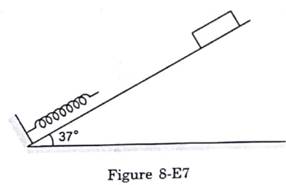Figure (8E7) shows a spring fixed at the bottom end of an incline of inclination 37°. A small block of mass 2 kg starts slipping down the incline from a point 4.8 m away from the spring. The block compresses the spring by 20 cm, stops momentarily and then rebounds through a distance of 1 m up the incline. Find (a) the friction coefficient between the plane and the block and (b) the spring constant of the spring. Take g = 10 m/s2.

The coefficient of friction is ![]() and the spring constant k = 1000N/m
and the spring constant k = 1000N/m
Given
The angle of inclination of the plane is given as![]() , a block is kept on the plane of mass 2kg and is kept from the spring at a distance of 4.8m, the compression distance of the spring is 20cm, and through the block to a distance of 1m.
, a block is kept on the plane of mass 2kg and is kept from the spring at a distance of 4.8m, the compression distance of the spring is 20cm, and through the block to a distance of 1m.
Formula Used
The coefficient of friction is the ratio of the Force and reactionary forces in terms of acceleration or gravity and the using the conversation of mass, we equate the energies of spring compression and potential energy of the mass of the block, the formula of the energy stored in spring compression is
![]()
And the energy stored in the block is formulated as
![]()
where
The value of spring constant is denoted as “k”, the compression distance is “x”, the mass of the block is given as “m”, ![]() is the coefficient of friction, the gravity of the block is “g” and the height at which the block is kept is h.
is the coefficient of friction, the gravity of the block is “g” and the height at which the block is kept is h.
Explanation
The block on the inclined plane is derived in two forms of derivatives with vertical being ![]() and horizontal as
and horizontal as![]() . Hence, applying conservation of energy we get the equation as
. Hence, applying conservation of energy we get the equation as
![]()
![]()
![]()
![]() ___________________1
___________________1
For the upward return motion of the block we have
![]()
![]() ___________________2
___________________2
Adding both the equation 1 and 2, we get the coefficient of friction as
![]()
![]()
Put the value of friction in the equation 1, we get the spring constant as
![]() .
.